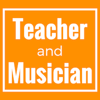As it so often does, last night’s MufuChat got me thinking. The topic was the mildly provocative ‘What is the point of getting students to listen to music in class?’ and it opened up a lot of discussion about what actually constitutes listening and why it’s useful (or not) for pupils and music teachers themselves. Broadly speaking, there were two main perspectives in the chat: formal listening and integrated listening.
Formal listening
When I say ‘formal listening’, I’m referring to the familiar concept of a ‘listening activity’. Pupils listen to a recording and respond to questions. Those questions are likely to have right or wrong answers and will be centred around key vocabulary (typically the elements of music). During last night’s chat, it appeared that music teachers fall into two distinct camps with formal listening:
- written responses
- verbal responses
A previous survey on this blog looked at written work in music lessons and suggested that
50% of schools make use of written work in their music lessons. It’s interesting to note that the MufuChat identified some of teachers reasons for including written work. These reasons included:
- preparation for GCSE
- improving musical vocabulary
- developing life skills
- intrinsic benefits
Not preparing for GCSE
Of these, the only one that I’m cautious of is the preparation for GCSE Music. The reality is that the majority (in most schools, the overwhelming majority) of pupils will not go on to study music when it comes to GCSE. Even then, I feel that the actual skills the pupils need can be better developed through practical activities than through formal listening exercises. A pupil who needs to understand the term legato for a GCSE listening exam will be much better at identifying and verbalising it if (s)he has learnt the term through performance.
When it comes to music education, I will always find it hard to justify an activity at KS3 on the basis that it’s good preparation for music at KS4. It’s even harder to justify when what you actually want them to learn (the ability to recognise and identify musical sound) is likely to be more effectively taught through practical activities.
Listening for listening’s sake
This idea came up when Rachel tweeted this:
This caused me to stop and think for a minute. If we were to look at the ‘likely’ path of our pupils, then more of them will probably spend time listening to music than performing/composing it. Rachel’s point is a great extension of my own logic when it comes to not planning KS3 as preparation for KS4 – if the majority of our pupils are only likely to listen to music, then why plan performance activities?
I guess that the answer to this question requires a return to my original argument for integrated listening – if we want to improve their listening skills and help them to get the most from it, then the most efficient way I know to achieve that is through practical performing and composing activities. Pupils are likely to better analyse, understand and identify with music if they’ve performed it.
Integrated listening
As I’m sure has become clear, I’m very much leaning towards the concept of integrated listening activities. By ‘integrated listening’, I mean the use of listening skills as part of a practical composing and/or performing task. A pupil who listens to a recording and then accurately performs a part from it has shown excellent listening skills. Vocabulary can (and should) still be developed in this manner too. In fact, this goes all the way back to my
very first blog post where I outlined a hypothetical discussion between pupil and teacher. In short, I stand by the following quote from that post:
“If my students are going to learn about a perfect cadence, they’re going to learn about it a lot more thoroughly and enthusiastically if they realise that they need to learn it – that they want to learn it.”

